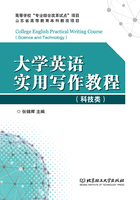
第四节 副词的用法
副词修饰动词、形容词和其他副词等,用来说明时间、地点、程度、方式、频率等,如:often, here, very, quickly, always等。除本身就是副词的,如now现在、there那里、rather非常,部分副词是由形容词加词尾-ly转换来的,如firmly坚决地,happily幸福地,也有部分副词与形容词同形,如straight adj.直率的,straight adv.坦率地;enough adj.充足的,enough adv.充足地;long adj.长的,长久的;long adv.长久地。副词可分为普通副词(如together, well, seriously, slowly, carefully)、疑问副词(如when, where, how, why)、关系副词(where, when)与连接副词(如then, so, therefore, however, hence, thus, nevertheless, otherwise, still)。
副词在句中可用作状语、表语等,最主要的功能是作状语,如:
What makes monarch butterflies particularly interesting is they migrate, all the way to California or Mexico in back.(CET-6, 2014.06)
It's quite interesting because the man is obviously used to teaching man.(CET-4, 2012.12)
Its informal conversational style would make interaction comfortable, and yet the machine would remain slightly unpredictable and therefore interesting.(CET-6, 2013.06)
Finally, he had a speech that was interesting and perfectly understandable to his audience.(CET-6, 2010.06)
Researchers having contributed greatly to psychology.(CET-4, 2012.12)
Since much of this energy comes from the utilization of fossil fuels, wastage of food potentially contributes to unnecessary global warming as well as inefficient resource utilization.(CET-6, 2013.12)